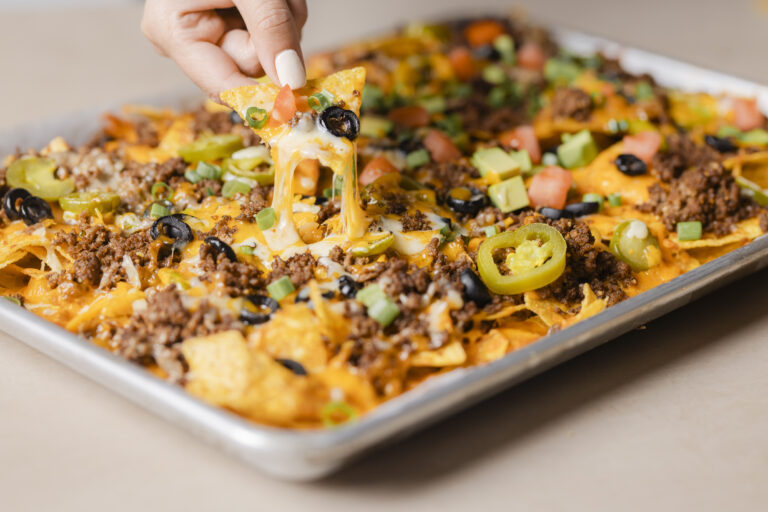Having more family meals at home? Change mealtimes from a struggle to a satisfying event with the division of responsibility.
Do you constantly find yourself fighting over meals with your children or cooking different meals to cater to a variety of food preferences in your household? Do mealtimes always seem like a struggle?
Figuring out how to teach your children about healthy eating habits can have its challenges. As nutrition educators, we understand that this isn’t learned overnight, and in fact, it can take many years. However, there are some tools that can help. With a few small changes and a little practice, you can create positive meal experiences with your family. Let’s find out how the division of responsibility can help!
What is the division of responsibility?
I’ve heard countless stories of dinnertime battles—battles that leave a sour taste in the mouths of both parents and children. So I am here to explain that mealtimes can be a positive experience for both parents and your children! Ellyn Satter, a dietitian and world-renowned specialist on eating and feeding, has devoted her career to teaching parents how to transform mealtimes from a challenging situation to a joyful, struggle-free event.1,2,3 She created the division of responsibility: a model parents can use to determine how their feeding responsibilities differ from their children’s.4
So, what is your responsibility as a parent?
Depending on your child’s age, the responsibilities of the child and the adult change. When a child is an infant, the parent is responsible for what and how much their child eats, to feed their child on demand and acknowledge their child’s hunger cues to determine the timing of feeding.5 As a child grows from an infant to an adolescent, the parent will still decide what foods are offered, but now also decides where and when to eat. At this age, the child now decides how much to eat and whether they will eat anything at all.
Below, you can see how responsibilities change slightly depending on the child’s age.1
| Child’s age | Parent’s responsibilty | Child’s responsibility |
| 0 – 12 months |
|
|
| 1 year and older |
|
|
At first, these different roles may seem challenging and difficult to implement; it’s not how most of us were raised. But as time goes on, and parents and children get used to this new structure, it becomes easier. In the end, the benefit of raising competent eaters outweighs the temporary “growing pains”. Children will better understand their hunger cues as well as develop the ability to make their own food decisions, leading to confidence in decision making and the ability to maintain healthy eating habits from a young age.
Food is food—not a prize to be won or a book of rules to follow
According to Ellyn Satter, when parents enforce parental restraints and food rules onto their children it may increase the incidence of disordered eating that can carry on into adulthood.2
Do you find yourself using phrases such as:
-
Try “just one bite”
-
Eat your vegetables first, then you can eat dessert
-
You haven’t touched your chicken yet
If you do use phrases like these around your children, you might decide to practice new ways of talking to create more positive mealtimes. One way to shift the dialogue is to encourage mealtime conversations surrounding events that happened throughout the day, instead of focusing on food. Creating positive mealtimes doesn’t have to be a struggle and it doesn’t have to happen all at once.
Ellyn Satter suggests that one of the first steps in teaching your children about food is understanding that food should not be served as a reward, a prize, or a special commodity.5 Food is just food. Even though it can be exciting when you see your children take a bite of a new food, it is important not to make it a big deal.
Food provides us with more than just nutrients—it provides community, flavour and experiences. Instructing your children to eat their vegetables before dessert can create unhealthy eating behaviours, or it can cause your children to believe that the dessert is superior or a prize to be rewarded. When you do decide to provide dessert at meals, it is important to explain to your children that everyone can have as much of the other foods as they want, but they will only have one serving of dessert—this may be difficult, but try to follow through with it because the structure is vital for learning.
Building a fundamental trust—do as I do
Your children look up to you and want to eat what you eat and do what you do. When you build a positive relationship with food, your children will see this and begin to start making positive choices on their own. It’s crucial for you to be a role model—to enjoy food and eat food that tastes good, that makes you feel good, and continue to offer a variety of foods that you enjoy. In time, your children will (eventually) learn to eat the foods that you like.
How can YOU start taking action today?
-
Whip up some delicious recipes to get your children excited about food:
Check out [bettertogether.ca] for delicious and simple recipes to make with your kids—getting them involved with food from a young age can help foster important food skills. If you continue to introduce your children to a variety of foods through cooking, eventually they will be more likely to start trying new foods. Don’t give up! Get them involved.
Try some of these recipes with your children:
A. Lemon Fluff
B. Asparagus and Strawberry Spring Salad
C. Grand-Maman’s Hazelnut Torte
-
Share this perspective with others who care for your children.
Early childhood educators can be a vital component of teaching children how to eat— check out some BCDA workshops that can spark children’s interest in food and nutrition.
3. Read some recent articles to support nutrition learning for your children:
A. The Not-So-Secret Garden: Introducing your child to gardening can lead to better eating behaviours.
B. Making memories – in the kitchen
By Carla Centola, year 5 dietetic student, with Carmen Gorlick, RD

References
- Healthlink BC. (2013). About Healthy Eating. Retrieved on May 02, 2019, from https://www.healthlinkbc.ca/healthy-eating/professionals/healthy-eating-meaning
- Kwan, C., Spencer, N. (2015). 2015 Annual Nutrition Forum Highlights: How We Eat Matters, with Ellyn Satter. Retrieved on May 02, 2019, from https://bcdairy.ca/nutritioneducation/articles/2015-annual-nutrition-forum-highlights-how-we-eat-matters-with-ellyn-satter
- Satter, E. (2019). The Ellyn Satter Institute. Retrieved on May 02, 2019, from https://www.ellynsatterinstitute.org
- Healthlink BC. (2018). Feeding Your Child Using Division of Responsibility. Retrieved on May 02, 2019, from https://www.healthlinkbc.ca/health-topics/ug2200#ug2200-sec
- The Ellyn Satter Institute. (2016). Division of Responsibility in Feeding. Retrieved on May 02, 2019, from https://www.ellynsatterinstitute.org/how-to-feed/the-division-of-responsibility-in-feeding/



